Tuesday, October 1st, 2020 by Julian Karsunky
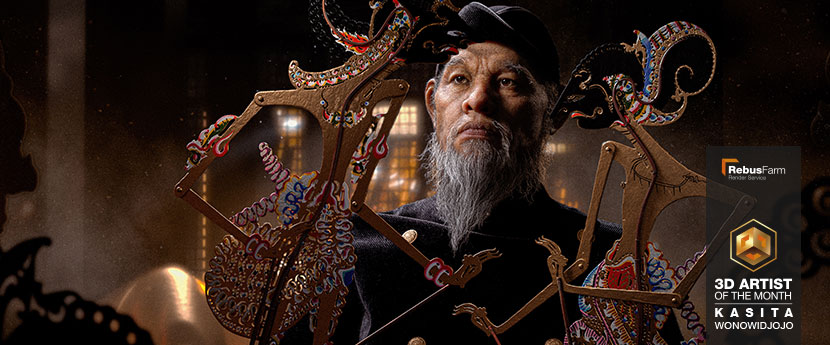
As technology advances, our means of communication change more than the stories we tell. With every brushstroke, characters new and old spring to life on the digital canvas of Kasita Wonowidjojo, our October 2020 3D Artist of the Month. Her hyper-realistic depiction of a Javanese puppeteer infuses a venerable tradition with cutting edge CG craftsmanship, earning her a prestigious Gnomon Best of Term awards among other well-deserved accolades.
In our interview, Kasita talks about cultural heritage, her “Second Life” as a 3D artist and the difficulties of obtaining a work permit amidst a global pandemic.
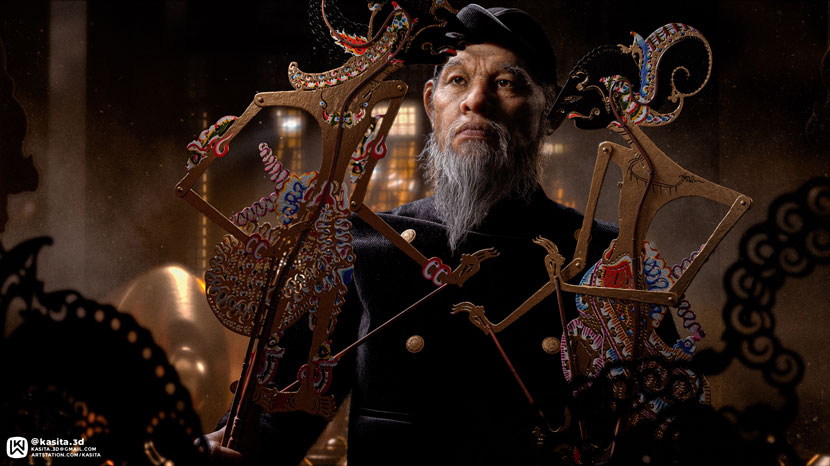 Kasita Wonowidjojo, ‘Wayang Dhalang’.
Kasita Wonowidjojo, ‘Wayang Dhalang’.
Hi Kasita, thanks for joining us! To start things off, please introduce yourself to our readers!
Hi everyone, my name is Kasita, I’m a 31-year-old 3D artist and recent graduate from Gnomon. I was born in Indonesia but raised in Singapore since I was a toddler.
Do you recall when and how you first consciously encountered CGI?
I first fell in love with the VFX industry through the work of Guillermo del Toro in ‘Pan's Labyrinth’. The world-building fascinated me. But I grew up in a rather traditional Asian family, meaning that arts weren't exactly encouraged as a viable career option. Instead, I pursued a business career and worked in marketing for six years, with my creativity being something I exclusively explored in my spare time.
Have you always been artistically inclined?
My own journey as an artist started digitally. While my mother and sister both painted, I did pixel art and computer graphics, so I always felt that the “fine arts gene” must have skipped me.
It was in the virtual realm of ‘Second Life’ that I became further engrossed in 3D. I taught myself Blender and ZBrush and became obsessed with creating virtual environments others could explore or interact with. Although I never considered myself a 3D artist at that point, merely a hobbyist.
But ultimately, you made the decision to switch careers and pursue your passion…
Yeah! Eventually, I enrolled in a Gnomon online course taught by Madeline Spencer; I thought it'd be fun to get better at ZBrush with the help of an artist I admire. Little did I know that class would be the push I needed: I decided to uproot myself at 29, which undoubtedly caused a couple of people to believe I was going through a quarter-life crisis. It wasn't that I didn't like my job, but I definitely didn't love it. Not pursuing my passion increasingly felt like a burden and distraction.
So, I decided to enroll myself at Gnomon full time to kickstart my transition into the VFX industry. My evolution as a 3D artist truly began at Gnomon.
As a recent graduate from Gnomon, please tell us more about your studies, the school community and your overall experience!
I love Gnomon, I can never stress that enough! I'm so grateful for the school and all the doors they have opened for me. I've also made lifelong connections there.
Gnomon is a school that is hyper focused on one thing and one thing only: making their graduates industry-ready, not only in terms of their technical expertise, but also in soft skills such as time management and general work ethics. What's even better is they do all that, but still give the students the freedom to explore their own artistry.
From students to staff, everyone is incredibly passionate. Having all your peers share the same goals and dedication is a powerful motivator. All of the instructors are working professionals who truly care about cultivating young talent for the industry.
On that note, I'm extremely grateful for learning from the likes of Tran Ma, Miguel Ortega, Christophe Desse, James Schauf, Damon Woods and Max Dayan, to only name a few. These are individuals who've pushed and supported me not only as an artist, but as a person as well!
You have managed to accumulate an impressive number of accolades during your time at Gnomon, starting with a full-fledged scholarship!
To be honest, I didn't even look into scholarships when I signed up for Gnomon, assuming I wouldn’t be eligible as an international student. Imagine my surprise when, on top of my enrollment agreement, I received the Founder's Scholarship Award for Distinguished Artists, which is awarded by the admissions office based on the portfolios submitted.
What were some of your personal highlights from your time as a student?
'Wayang Dhalang' is definitely among my favorites, as it’s my most personal piece yet. But the project I had the most fun working on, though unfinished, is 'Tea?'. There’s still plenty of work to be done on that one, but eventually, it will be a whole group of sassy animals dressed in ornate Victorian fashion having tea together!
It started during my last term as a fun, yet ambitious side project next to extensively working on my demo reel. The reason I’m so fond of ‘Tea?’ is while I put all I had learned at Gnomon into creating it, I still pushed myself one step further and learned Yeti grooming on my own. Knowing I still found it in me to take on an extracurricular activity as this, despite how tired I was at the time, further solidified my love and determination for the craft!
Having travelled back and forth between the U.S. and Southeast Asia over the years, how easy was (and is) living and working in different cultures?
For the CG industry specifically, I noticed that in the US, you will most likely work within already established structures, like an organized pipeline, for example. The industry in Southeast Asia is still comparatively new, so it’s not unusual to find yourself actively developing some of these workflows as part of a job. There are pros and cons to both.
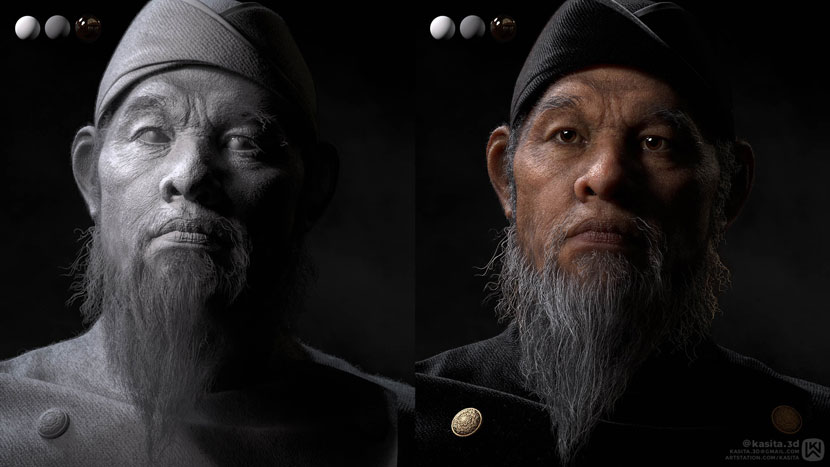 ‘Wayang Dhalang’, work in progress. Be sure to check out the extensive project breakdown Kasita wrote for The Rookies.
‘Wayang Dhalang’, work in progress. Be sure to check out the extensive project breakdown Kasita wrote for The Rookies.
Speaking of, please tell us about your current job situation!
I do hope to stay in the US, mostly because many of the studios I admire are based here and I see the biggest potential for personal growth working in such an environment. However, there's always the possibility of me exploring Canada or Singapore as well. For the time being, I go wherever work opportunities will take me!
Fingers crossed! How would you describe your profile as a 3D artist?
I originally started as an environment artist, but over time, my focus shifted to characters. My skill set lies in modeling, texturing, and look development; the latter of which I have grown to particularly enjoy, thanks to the classes by Tran Ma. Problem-solving in a CG context is something I find equally challenging and satisfying, such as trying to figure out the right look of an object or material to suit a client’s needs.
Understanding the fundamentals to be able to approach various rendering engines and platforms is also something I want to improve at and be flexible for in an ever-growing industry.
Is there a specific design philosophy or school of thought you adhere to? What inspires you as a 3D artist?
Whatever I do, I like to either have a story in mind or a message I want to portray visually. When that storytelling element is in the heart of the piece, everything else falls into place. I’ve always been that odd kid who daydreamed too much in class, so I think I’m naturally channeling that part of me through my art now.
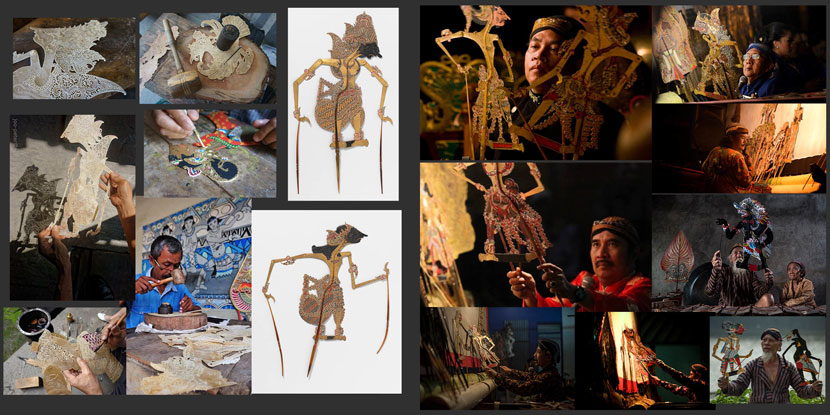 Just two of the many reference sheets Kasita put together for the project, showcasing the creation of the intricate puppets and various Wayang performances.
Just two of the many reference sheets Kasita put together for the project, showcasing the creation of the intricate puppets and various Wayang performances.
On your website, you cite your cultural heritage and its rich history in traditional craftsmanship as a source of inspiration. Can you elaborate on this point?
Indonesia has a rich artisan tradition, there's a lot of respect for creating things with your hands. Batik textiles, wood carving, and puppet making are just a few examples of crafts that constantly surrounded me as a child. When I returned to living in Indonesia in my twenties, I noticed many of these traditional art forms were in decline as a result of a more “modern” way of life.
Is it important to you personally to uphold such traditions in an increasingly globalized (art) world?
While I want to incorporate such elements into my work, it’s not so much because I consciously feel obligated to uphold a specific tradition, but more out of a desire to lend a general artisan quality to my pieces. The more proficient I became at 3D, the more fascinated I became with doing handcrafted work in CG: carving wood in ZBrush, creating embroidery in Substance Designer…my very first Intro to Maya project involved hand weaving a wicker chair in for five weeks straight!
CG artwork is always at the risk of appearing slightly too perfect, too machine-made, I feel. To counterbalance this, I like having these hand-touched, organic components in honor of traditional craftsmanship.
Let’s talk about your work in more detail, namely your submission to our campaign, the ‘Wayang Dhalang’, a dignified Indonesian puppeteer. Can you first of all describe the circumstances that lead to the creation of this piece. Was it a personal project or part of a particular assignment?
I started working on this piece during my look dev class with Miguel Ortega, then polished it during my last semester at Gnomon. At the time, I felt incredibly nostalgic, I missed home and kept thinking of the people I had to leave behind to get to where I am. These feelings went into the project, it serves a tribute to my culture and to my father, who has always been a huge role model to me. Wayang shows were his favorite form of entertainment growing up, and he collected a bunch of these puppets in our home!
Please tell us more about the art of the dhalang, the significance of the puppets and traditional wayang theater!
Wayang refers to classical Javanese puppet theater, performed by a Dhalang, the puppeteer. They were played in street-side booths but also midnight-to-dawn shows during important events. Nowadays, it’s a dying art form.
Dhalangs are revered like priests. They are artists and storytellers, weaving epic tales behind a translucent screen. Their craft mimics ours as CG Artists, only we create our stories through different screens. The Wayangs are the vessel, or, to put it in more artistic terms, the medium through which they tell their stories. There are actually various types of Wayangs in Indonesia, the one I referenced is the Wayang Kulit, which translates to skin, as the puppets were traditionally made from buffalo hide.
What were your main goals in doing this project? What parts of the image were particular important to you?
It was important for me to make a shot that felt intimate, almost like you caught an artist in a personal moment with his craft. This is also why I aimed for a hyper-realistic approach for this piece. I looked at many photojournalism pieces as inspiration for the overall composition.
What were some of the challenges you had to overcome?
Initially, the biggest challenge was the puppets. I actually convinced my mother to send some over from Indonesia for reference and realized how intricate they were. These were so forefront in the shot, they couldn't just be done with a texture on a plane. I manually placed all those holes and tried to stay true to the actual puppets I had. For anyone curious, the two puppets I modeled were Arjuna and Yudistira.
Trying to create a dignified Indonesian male was also really challenging. I hadn't done anything with this level of realism, so I had a lot of feedback from my professors and Henry Chervenka, who provided key input and moral support for me at multiple stages of this project.
Once you had a basic concept in mind, how did you approach realizing it?
What software did you use to create this piece? Any plug-ins you found particularly helpful?
Most of my projects start off very similarly. I create blockouts and a camera to be able to hone in on the shot I need. This allows me to allocate time and see which items are the most significant to the piece.
Modeling and Sculpting were done in Maya and ZBrush; I had a lot of help with live Booleans in ZBrush to create the puppets. The clothing items were done in Marvelous Designer. The texturing of the character in Mari and the rest of the textures and shaders were procedurally done through V-Ray. I really wanted to do these procedurally to challenge myself and learn more about working with Maya's hypershade window.
V-Ray Fur and XGen were the two grooming plugins I used for anything fiber/hair related in the project. Lighting in V-Ray is a dream for character projects as well.
Are you satisfied with the results? What has the feedback been like?
I am satisfied, but I'd be lying if I said I didn't spot a ton of errors. It can be challenging to shut an artist's brain up in that regard. But the feedback to this piece has honestly blown me away! At Gnomon, I received the grand prize in the Spring 2020 Best of Term showcase, I was runner-up for the Rookies Awards 2020 in the VFX category, and now I’m recognized as your 3D Artist of the Month as well – I honestly couldn’t wish for more and I’m thoroughly grateful!
What is one thing you have learned from this project that you can share with us?
Technically speaking, I think the biggest thing I learned with this project was shader development. Before Gnomon, I would texture everything in Substance Painter and over-rely on the software to generate my materials for me, not taking time to understand what made a material look the way it did. This project pushed me to look into the nodes I'm using to procedurally create a material.
On a more personal level, I learned to follow my instincts when choosing projects. Don’t only pick a subject because of its assumed popularity, but because you are personally invested. At least as students, this is a luxury we still have!
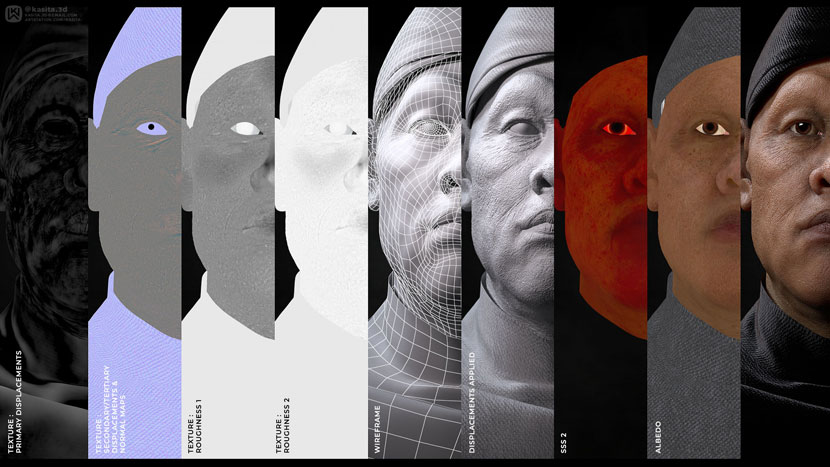 On a technical level, Kasita’s ‘Wayang Dhalang’ was an exercise in procedurally generated textures and shaders.
On a technical level, Kasita’s ‘Wayang Dhalang’ was an exercise in procedurally generated textures and shaders.
Considering the path you have already traveled up to this point, what is some advice you would give aspiring artists?
Working hard is a must, but it’s not everything. You also have to work smart, self-reflect and properly evaluate your strengths. Then, hone in on those and spend whatever time you have left to fix what you’re weak at. It seems simple enough, but it takes a lot of self-discipline to wake up and work at getting better.
While I think it’s incredibly important to have artists you admire as a benchmark for where you eventually want to be, only compare yourself to who you were yesterday. Furthermore, base your artistic decisions on what fits you, and recognize that this field is a never-ending journey of growth and learning.
Have you used RebusFarm before? If so, please tell us about your overall experience. Is there anything you especially like about our service?
Yes! At Gnomon, we’re fortunate enough to get student discounts on RebusFarm, which significantly helped with my final demo reel. I would render huge static images on my own computer and any point I needed an animation sequence, I trusted RebusFarm to handle it for me.
In closing, is there anything else you want to say? Any present or upcoming projects you’d like to mention?
I’m incredibly honored and grateful to be featured as your 3D Artist of the Month! To see my piece amongst all these other amazing artists is deeply humbling. In trying times like this, successes like this mean the world to me and encourage me to keep persevering. Thank you so, so much!
Thanks to everybody taking time to read through this, and again, to RebusFarm for giving me this opportunity to talk more about my culture and my piece!
The pleasure is all ours! Kasita, thank you so much for taking the time and all the best in the future!
Keep up with Kasita Wonowidjojo and her work here:
HOW TO JOIN OUR MONTHLY CONTEST
You want to be our next featured 3D Artist of the Month and win 250 RenderPoints? Just visit our 3D Artist of the Month competition page and submit your entry. We'll choose the best image and contact the winner.
>> Read more articles on our blog
